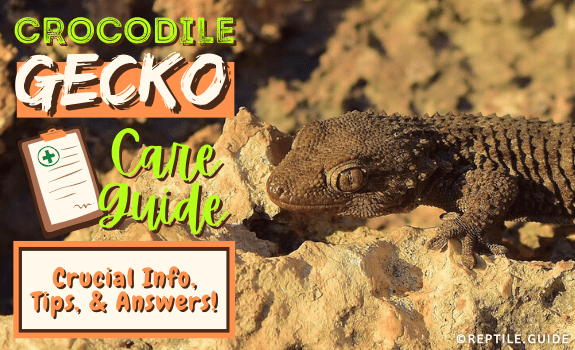The crocodile gecko or Moorish gecko, Tarentola mauritanica, is a medium-sized gecko best kept by itself or as female pairs.
It gets its name from its flat head and slightly elongated snout which resembles a crocodile.
Moorish geckos are an active species that require a large terrarium but are easy to care for.
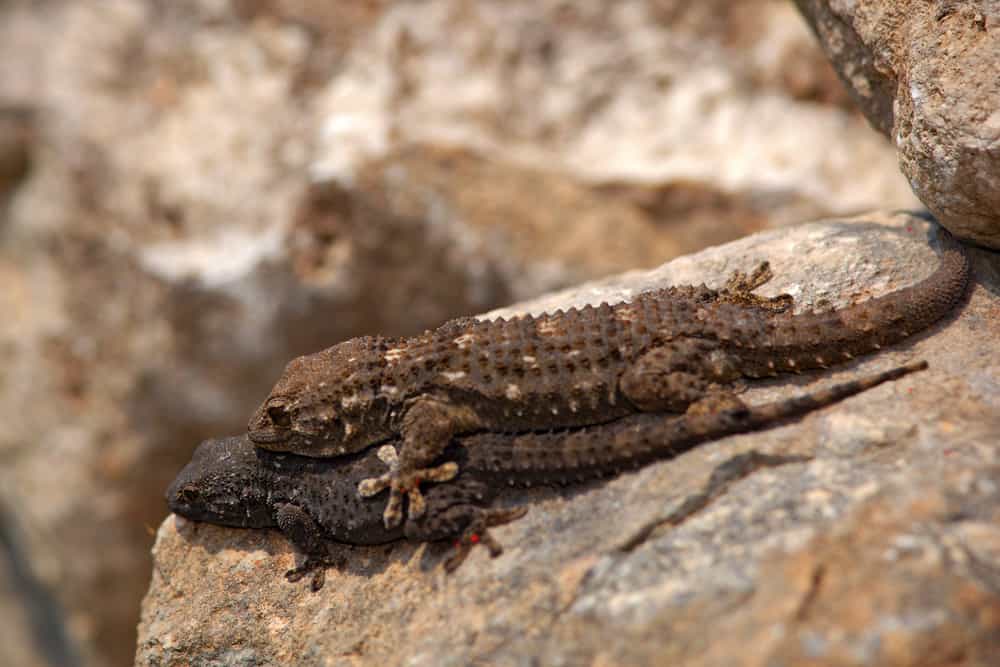
Let’s take a closer look at the crocodile gecko care needs and the origins of these geckos.
In This Article
Crocodile Gecko Background Information
The Moorish gecko is a common species in the Mediterranean regions of Europe and Northern Africa.
In fact, in parts of North Africa, this species has the name “Common Wall Gecko.”
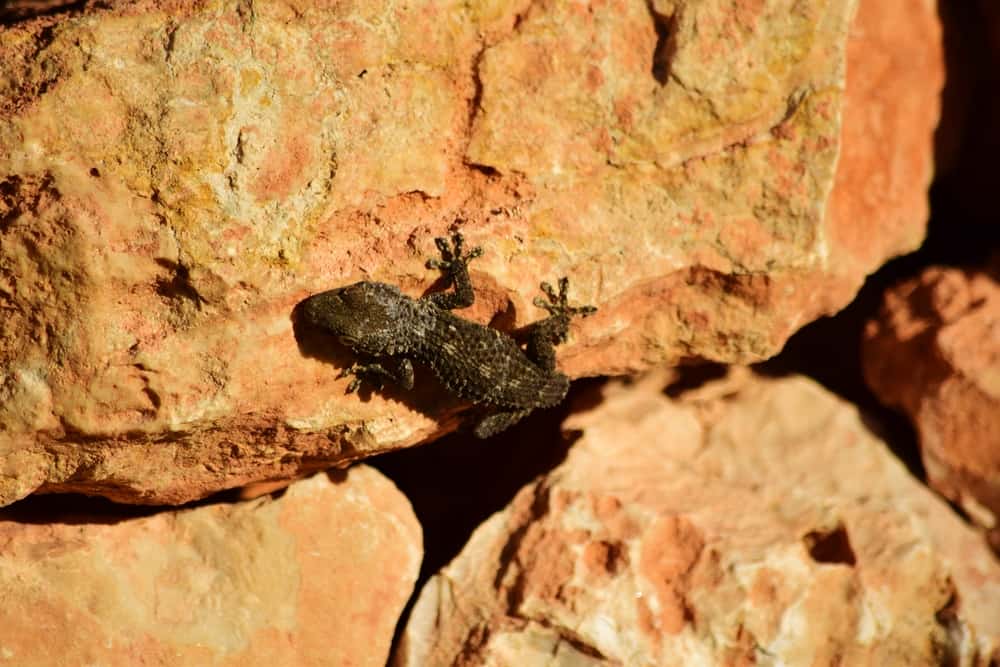
Its range in North Africa includes:
- Morocco
- Northern Libya
- Northern Egypt
- Northwestern Sahara
- Tunisia (Northern and Central)
Its range in North Africa also includes an isolated population in the south of Western Sahara.
In Europe, the range of Moorish geckos includes:
- Southern France
- The Italian Coast
- Southern Slovenia
- The Croatian Coast
- The Southwest of Greece
- Most of the Iberian Peninsula
Outside their natural range in the Mediterranean region, Moorish geckos have also established themselves in other countries.
Invasive colonies exist in:
- Spain
- Uruguay
- Portugal
- Argentina
- United States
Crocodile Gecko Habitat
The natural habitat of Moorish geckos in the Mediterranean region typically includes rocky areas.
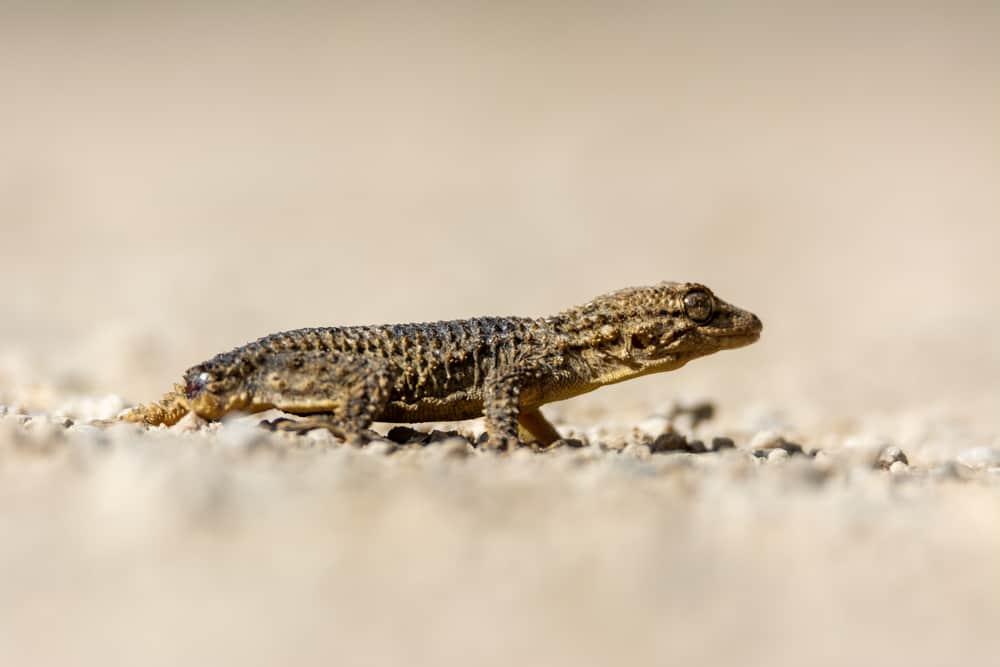
They naturally prefer cliff faces or shrubland with plenty of nooks and crannies they can hide in.
This type of habitat is common in the areas of Southern France and Northern Africa, where these geckos are most common.
However, these geckos gladly replace one environment for another with enough hiding places and food sources.
Whether it’s Northern Africa, Southern France, the Mediterranean region, or the Americas, Moorish geckos can make it.
Its ability to cohabit with humans means that the Moorish gecko will probably become a cosmopolitan species like the house gecko.
Crocodile Gecko Lifespan
The average lifespan for Moorish geckos in captivity is around ten years. A pet Moorish gecko can live for up to 15 years under ideal conditions.
Unlike most reptiles, the Moorish gecko has a similar life expectancy in the wild. This is largely due to its excellent camouflage and hiding abilities.
How Big Do Crocodile Geckos Get?
The Moorish gecko reaches lengths of around 5.9 inches, tail included.
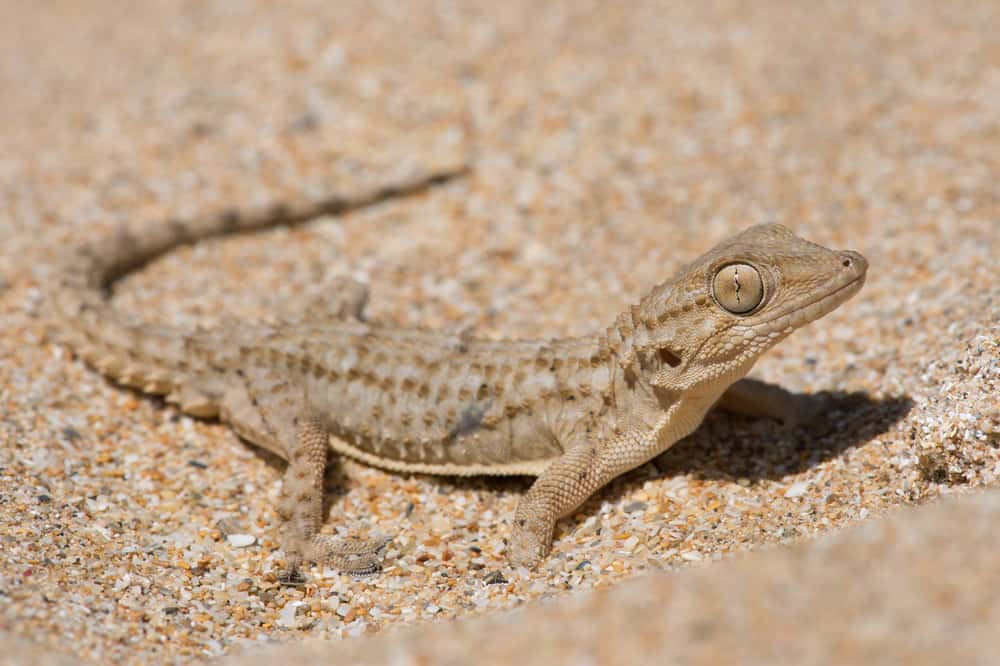
Moorish geckos aren’t a large species when compared to other common pet geckos.
Leopard geckos reach lengths of 7.9 inches, and giant day geckos reach lengths of up to 10 inches.
For the gecko family as a whole, the Moorish gecko is medium-sized. However, it’s small compared to most pet gecko species.
As with many gecko species, Moorish geckos have long tails.
The tail may make up one-half of the gecko’s overall length, or even a bit more than half.
Crocodile Gecko Price
The Moorish gecko is an affordable species since it breeds easily in captivity.
You can expect to pay around $25 per gecko, depending on the breeder.
If you buy your new gecko from a top breeder, the crocodile gecko price can be as high as $50.
Overall, the average purchase price for these geckos is between $20 and $30.
Where to Buy a Moorish Gecko
Many hobbyists and breeders breed these geckos thanks to the ease in breeding them.
This diversity of breeders means that you can buy crocodile geckos from a variety of places.
Repticons or Reptile Expos
One of the best places to look for any type of lizard or reptile that you’d like to buy is a local reptile expo or your nearest reptile convention (Repticon).
Repticon hosts hundreds of breeders from around the US and has a strict process for checking all the applicants.
You’re almost guaranteed to find at least one stall with crocodile geckos for sale at this type of expo.
Private Breeders
Your next best option is to buy directly from a private breeder.
You can ask around on reptile forums to find out if there’s a reputable breeder in your region.
You’ll find many keepers who can point you in the right direction.
If there isn’t a breeder in your immediate vicinity, consider ordering Moorish geckos online.
A simple Google search delivers multiple trusted breeders who have these geckos for sale almost year-round.
Pet Stores
Avoid buying these geckos from a pet store, even if you find one that stocks them.
Many pet stores can’t say for certain if their animals are imported from the wild or how the geckos were kept before they arrived there.
It’s essential to know if the gecko is captive-bred or wild-caught since wild geckos need special care.
You need to treat wild-caught animals in case they have internal or external parasites.
Crocodile geckos from Europe are particularly susceptible to endemic species of Coccidia (an internal parasite).
If you find a pet store that can put you in touch with the gecko breeder, then you can consider buying from them.
Crocodile Gecko Tank Setup
These geckos are adaptable, and a crocodile gecko tank setup doesn’t need to be fancy. However, they have some basic requirements to help keep them healthy.
Substrate
Finding the ideal substrate for crocodile geckos is an unusual conundrum.
This species requires a medium-low humidity level, so you can’t use a highly absorbent substrate, nor one that’s too dry.
Most keepers suggest using a one to two-inch layer of calcium sand or bark bedding in the base of the enclosure.
Some hobbyists suggest using vermiculite, but its absorbency can be a problem if you’re already struggling with high humidity.
This layer forms the base of the substrate and helps to maintain the enclosure.
On top of the base layer, you can add a bedding layer. Add around one-half inch of bedding.
If you live in a dry area and need to get the humidity levels up, you can consider coco peat or peat moss. Sphagnum moss also works.
If your humidity levels are high enough, you can use a drier bedding type. Good options include aspen shavings and corn husk bedding.
Heating
These geckos hail from warm, temperate regions. Keeping the enclosure warm enough is essential to their well-being.
As with all reptiles, these geckos are cold-blooded and can’t adjust their internal temperatures.
They ensure that their bodies are in the appropriate temperature range by moving between warm and cold areas.
Pet geckos need a temperature gradient to stay healthy. You can provide one by heating one side of the enclosure and leaving the other side unheated.
Aim for the following temperatures in a common wall gecko enclosure:
- Hot Side – 90 °F to 95 °F
- Cool Side – 75 °F to 80 °F
- Ambient Temperature – 80 °F to 90 °F
- Nighttime Temperature – 65 °F to 75 °F
This set of temperatures best matches the warm, temperate regions that these geckos naturally reside in.
Aim to have three thermometers in the enclosure:
- One on the cool side (for measuring the cool side’s temperature)
- One on the warm side (for measuring the basking spot temperature)
- One in the center of the tank (for measuring the ambient temperature)
You have a few options for heating the warm side of the habitat. These include the following:
- Heating Pads/Mats – Heating pads and mats work well for nocturnal geckos because they don’t produce any light.
You can use them both day and night as either a primary or secondary heat source.
If you decide to use a heating pad, we suggest incorporating a thermostat. It will help keep the temperatures in range without you constantly making adjustments.
- Ceramic Heat Emitter – Ceramic heat emitters are a type of heat-producing bulb that doesn’t generate light.
They’re excellent heat producers, but you should incorporate a lamp guard to prevent your gecko from touching the heat source.
This heating device, possibly combined with a heating pad, is ideal for nocturnal animals like crocodile geckos.
Unlike heat lamps, which produce light, you can use a ceramic heat emitter day and night.
- Basking Lamp or Heat Lamp – While a basking lamp can be useful, it’s probably not the appropriate choice for crocodile geckos.
These lamps produce both light and heat, which means that you can’t run them at night when the geckos are the most active.
If you want your gecko to have the potential benefits of UVB, consider using a heat lamp or basking lamp during the day and swapping to a heat emitter or heating pad at night.
We recommend using a combination of a heating pad and a ceramic heat emitter.
Neither of them produces light, so you can use them 24 hours a day to keep your gecko’s enclosure in range.
If you want to experiment with the benefits of UVB, use a basking lamp during the day and the heating pad/heat emitter combo at night.
Remember that, as lizards need a day and night light cycle, they need a day and night heat difference.
Offering the 12-hour cycle in light and temperature mimics the natural conditions in the wild.
Lighting
Although crocodile geckos are nocturnal, they still need some degree of lighting to stay healthy.
As with any lizards, these geckos need a day and night cycle to help them stay healthy.
In most cases, we’d recommend a cycle of 12 hours with light, and 12 hours without.
For these nocturnal geckos, that would mean you never see your pets.
We suggest 12 hours with a full-spectrum bulb and 12 hours with a night-specific bulb. Night-specific bulbs have a design that mimics moonlight.
They generate enough light for you to see your geckos, but don’t affect the day-night cycle and won’t disturb your gecko’s nocturnal habits.
We suggest using a full-spectrum LED bulb for daytime lighting.
Water and Humidity
Crocodile geckos should have access to fresh drinking water at all times.
However, try to keep the relative humidity between 40% and 60% at all times.
We recommend buying a hygrometer so you can monitor the humidity.
Excessive humidity can lead to breathing problems and lung damage in these geckos.
The best way to keep the humidity in the range is to:
- Use a screened lid on the enclosure
- Place the water bowl on the cool side of the enclosure
- Use a substrate that doesn’t maintain a high moisture level
If you live in a dry region, you may find that you need to boost the humidity to keep it in range.
You can try the following to help boost humidity:
- Mist the enclosure substrate every couple of days
- Use a substrate blend that provides slightly more absorption
- Move the water bowl around till you find a place where it provides the amount of humidity you need
Hides
Crocodile geckos come from rocky areas and will appreciate the addition of plenty of hiding places.
While you can add the traditional hides to a crocodile gecko habitat (one on each side of the enclosure), that may not be the best option for this gecko.
Some keepers use non-toxic silicone to glue together slate and other similar stones to form hides.
This way, they can create rocky areas and distribute them throughout the habitat.
Since these geckos prefer living in niches and crannies of crags and other rocky areas, these hides mimic their natural behavior.
Whichever hides you choose, ensure that some are on the warm end of the tank and some on the cool end.
Crocodile Gecko Diet
The crocodile gecko diet should be balanced and consist of multiple types of insects.
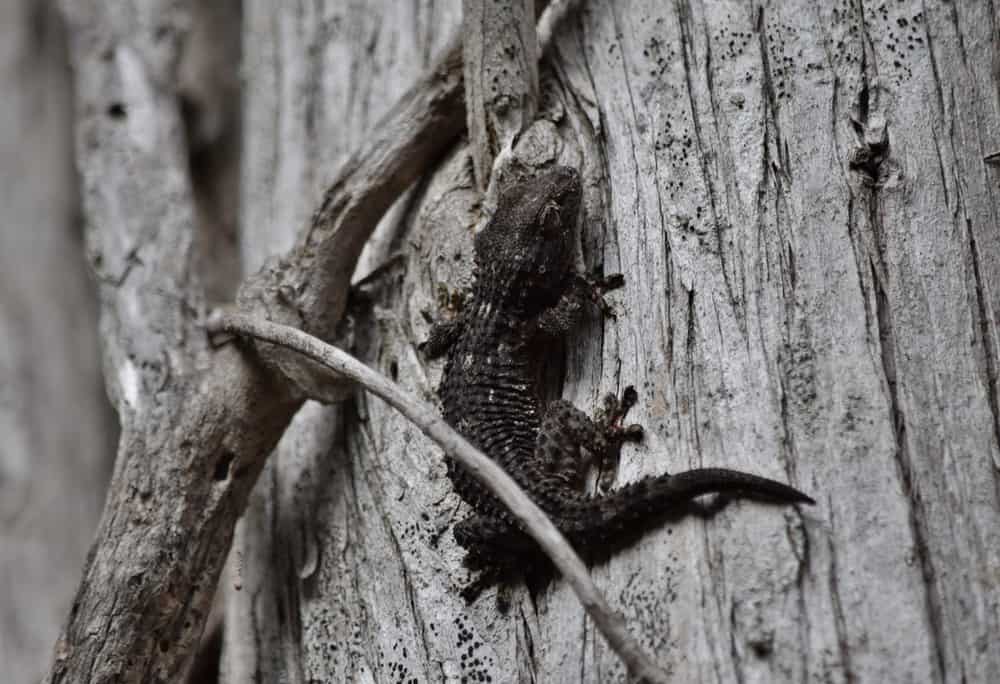
Fortunately, there are many options on the market. These include:
- Crickets – Ensure that you choose a suitable size for your gecko. Feeding crickets that are too big for your pet can lead to injury.
- Mealworms – These insects have a high-fat content. Don’t overfeed them to your geckos.
- Superworms – Young superworms are an excellent food source with high protein and low-fat content.
- Black Soldier Fly Larvae – Choose a small size that’s still soft and easy for your gecko to digest. High in protein.
Avoid feeding waxworms to your geckos. They have a much higher fat content than the insects on this list and contribute to obesity in geckos.
Remember to always dust your gecko’s food with a high-quality calcium powder to ensure that it gets enough calcium in its diet.
They also have a high requirement for Vitamin D, so you might want to use a multivitamin as well.
Crocodile Gecko Temperament
Crocodile geckos are calm, peaceful animals but not pets in the traditional sense.
These geckos are non-aggressive and won’t attack you. However, they also won’t let you pet them.
Crocodile geckos have a flighty nature and will flee from any attempts to handle them.
They’re display animals rather than pets, and if you insist on picking them up, they WILL lose their tails.
Moorish Gecko Health Issues
The Common wall gecko has a robust body and immune system.
This species isn’t prone to disease but can suffer from the common illnesses and issues that affect geckos.
Are Moorish Geckos Good Pets?
Moorish geckos are excellent pets if you don’t mind a display pet rather than one you can can handle.
These animals are low-maintenance, non-aggressive, and have few major requirements.
If you think they’re beautiful, and don’t mind having a pet that you can only look at, then the Moorish gecko is perfect for you.
Do Crocodile Geckos Need UVB?
Crocodile geckos are nocturnal and don’t need UVB lighting to stay healthy.
However, some hobbyists believe that, even if not essential, UVB lighting can be beneficial for nocturnal reptiles.
Some of the perceived benefits include brighter coloration and stronger immune systems.
There’s also some evidence that UVB lighting helps to combat the effects of metabolic bone disorder.
Problems Shedding
Geckos kept in enclosures with insufficient humidity levels often have trouble shedding.
If this is a problem for your geckos, try boosting the humidity in the enclosure (if it’s low).
One of the best things to do is add a humid hide for your gecko.
A humid hide is a plastic box with a single entrance and filled with moist substrate.
It has higher humidity, and the gecko can climb inside when shedding.
Metabolic Bone Disease (MBD)
MBD results from an inadequate diet that lacks calcium.
Ensure that you give your geckos a varied diet and enough calcium/minerals from a young age.
MBD prevents the gecko from building a strong bone structure and can lead to general weakness,
If your reptile seems to be getting bowed legs, a soft jaw, or weak bones, take it to a reptile-exclusive vet immediately.
A vet will tell you how to treat your pet and if the problem is reversible.
Parasites
These geckos, especially if wild-caught, are susceptible to a few internal parasites.
Coccidia and worms are the most common. If your gecko has runny droppings, displays weight loss, or has a loss of appetite, take it to a vet.
It’s a good idea to have your vet do a parasite test yearly, so you can treat the animal if needed.
We hope you’ve enjoyed this article about crocodile geckos.
We have plenty of other gecko-related content for you to look at.
From the unusual flying gecko to the leachie gecko and crested gecko, this family is a wealth of fascinating pets.
What’s your favorite gecko species? Let us know in the comments.
